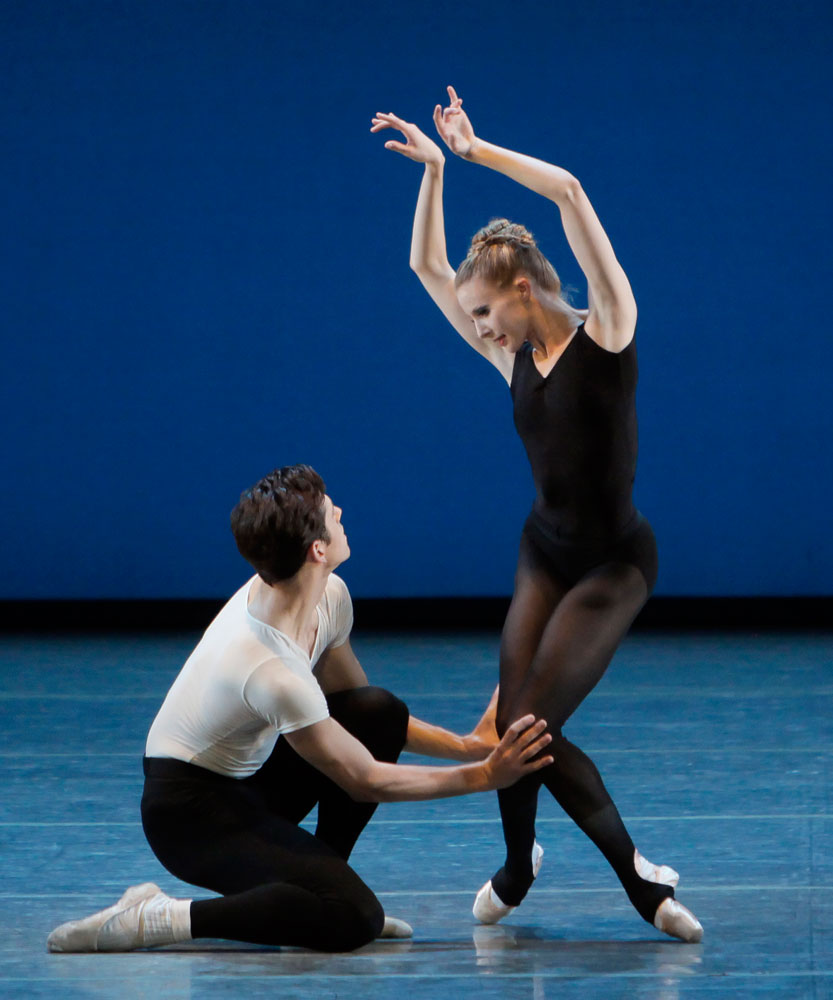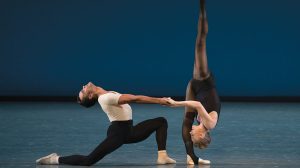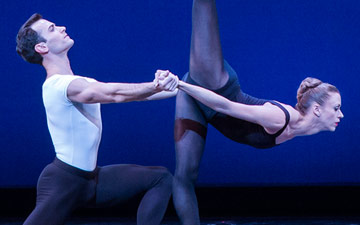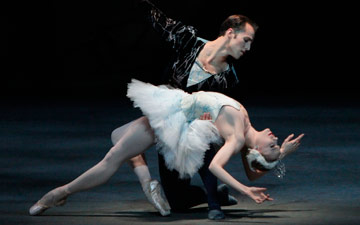
© Paul Kolnik. (Click image for larger version)
New York City Ballet
Concerto Barocco, The Four Temperaments, Stravinsky Violin Concerto
New York, David H. Koch Theater
2 March 2014
www.nycballet.com
Back to Basics
After a busy six-week run that included three farewells (Janie Taylor, Sébastien Marcovici, and Jenifer Ringer) and a new work by an emerging star (Liam Scarlett’s Acheron), New York City Ballet ended its winter season as it began it, with a program of Balanchine works. All three – Concerto Barocco, The Four Temperaments, and Stravinsky Violin Concerto–are plotless and performed in crisp rehearsal-wear: leotards (some adorned with simple white skirts) and tights. All three are rigorous interpretations of their scores, down to the interplay between orchestral voices, the repetition and overlaying of phrases, and the da capo structure.
Watching these three ballets, made over a span of thirty-two years, one can see how Balanchine’s style evolved toward the hyper-stylization of Violin Concerto (1972), but also how certain obsessions remained constant. Always, first and foremost, the elaborate and courtly manners, encapsulated in the monumental gesture of the offering the hand, slow, measured, grave. And the enduring interest in Baroque courtly dance, with its lilting rhythms, clapping of palms, sprightly footwork, and small revérences. And the seamless juxtaposition of Baroque courtliness with jazzy steps, hip bumps, struts and eccentric moves like the “thumb” dance in Violin Concerto, the zombie walk in Four Temperaments and a charming prance in Concerto Barocco in which the women lift one turned-in knee while stretching their arms back like cricket wings. Then there are the daisy-chains that scroll into Gordian knots and, miraculously, unravel and dissolve. These, and myriad other little details remind us that what we are seeing could only be a Balanchine ballet.

© Paul Kolnik. (Click image for larger version)
One of the quirks of the theatre is that you can never predict what the high points will be. On paper, the pairing of Sara Mearns and Teresa Reichlen in Concerto Barocco would seem peerless – Reichlen’s Guineverean serenity crossed with Mearns’s urgency – but Reichlen was having an off day and seemed a tad disconnected from the choreography. Hers was a cautious, soft-focus performance – though one with lovely, plush lines – almost but not quite behind the music (or was it simply a lack of accent that made it appear so?). In the slow second movement, in which she was ably and self-effacingly partnered by the corps-member Russell Janzen, Reichlen wasn’t able to hold the arc of the violin melody, the continuous flow – like a single thought – that, at its best, leaves you exhausted and breathless by the time the recapitulation comes around. (On the other hand, I now regret missing Janzen’s début in Diamonds alongside Reichlen. He is both confident and strong enough to partner the lankier ballerinas, a major advantage in this company, and he has a grounded, unforced presence.)
Meanwhile, Mearns tore through the choreography with that ferocious hunger that always makes her fascinating to watch. Her entrance in the second movement, in which she sashayed down the diagonal as if life itself awaited her in the opposite corner, was a major event. The ensemble danced with poetry and a kind of discreet intelligence, enhancing the sense of being inside a perfect machine.
The company’s casting decisions for The Four Temperaments, Balanchine’s early modernist masterpiece, are hit or miss these days. The good news is that the company gets the ballet and shows off its Art Deco poses with authority and style, but as a whole, its execution lacks freshness. The harpy-like prancing on pointe and the straddling legs for the women, the flexed feet and Egyptian arms, fail to surprise; we take them for granted as stylish flourishes. (This evenness of tone was made even more striking in contrast with the next ballet, Stravinsky Violin Concerto, in which every movement bristled with wit.) But there were high points here as well, like Gonzalo García’s plush, aching backbends and weighty falls to the ground in Melancholic, complete with the heavy thud of his body hitting the stage. (How is it that this dancer excels in both sweet, guileless roles like Frantz in Coppélia and in dark, introspective parts like Melancholic and the lead in Robbins’s Opus 19/The Dreamer?)

© Paul Kolnik. (Click image for larger version)
And then there was the delicate eroticism with which Ashley Laracey unfurled a leg or allowed herself to be pulled forward like Eurydice in the ballet’s third section (or “theme”), a pas de deux with Justin Peck. And Ashley Bouder’s furious, almost demonic entrance in Choleric, an irruption that brought to mind the phrase “like a bat out of hell.” Her legs sliced the air in turning gargouillades (jumps in which each leg traces little circles in the air), and, during the piano cadenza, she whipped herself into a Tasmanian-Devil-like flurry of chaîné turns – a spinning blur. Here, unhampered by a partner, free to fully unleash her prodigious speed and force, Bouder is un-matched.
But the best was yet to come: Violin Concerto turned out to be the performance of the afternoon. The orchestra, under the baton of Daniel Capps, played the Concerto in D with uncharacteristic swing, bringing out its sparkle and wit, the interplay of voices (horns, violin, woodwinds) and contrast of textures (staccato, blaring, jabbing, and then, suddenly, in the third movement, hyper-Romantic). The violinist Kurt Nikkanen delivered Stravinsky’s musical in-jokes like a standup comedian on a roll, and the dancers responded in kind. The opening, with its sequential “teams” – a woman and four men, a man and four women, then a single-sex squad of women followed by a crew of men – sparkled with tongue-in-cheek competitive spirit, reminiscent of the sporty chase Balanchine created for Edward Villella in Rubies. Sterling Hyltin cavorted with the boys, shook her shoulders and hips, skipped, and shimmied; the men spun like tops or kicked their legs like Rockettes. The Concerto’s finale, with its gawky arm dances, tapping feet and two-footed pogo jumps, was just as gleeful, with Robert Fairchild and Amar Ramasar leading the romp.

© Paul Kolnik. (Click image for larger version)
Tucked inside this jaunty exterior are two extraordinary pas de deux, or “arias,” each set to a movement of Stravinsky’s concerto. The first, danced by Maria Kowroski and Amar Ramasar, is a highly sophisticated portrait of power dynamics, in which each partner vies for dominance. Feigned protestations of vulnerability and sudden power plays abound. Each combatant marks his territory, first with an extended foot, then with both hands, fingers splayed like those of a mime. The man jumps, feet flexed, emphasizing a point, as the woman looks on, unconvinced. Then she dives to the ground, arching into a backbend, crawling around him like a strange animal. It’s an extraordinary move, and the moment always comes as a surprise. With her elongated body, Kowroski is particularly striking here, like a spider, but both she and Ramasar could add a little more aggression to make this duet sizzle all the more.
The second aria reveals a different dynamic, based on clingy co-dependence between the two partners, danced by Robert Fairchild and Sterling Hyltin. Hyltin is a compelling and subtle actress, able to infuse drama into a situation with a small pause, an extra twist of the shoulders, a flash of the eyes. Fairchild, too, seems to throw himself into every dramatic situation with generosity and open heart. In this duet, his hands almost never leave his partner: he flips her over in his arms, three times, pulls her knees together, pushes her across the floor like a wheelbarrow, and puts his arm around her shoulders in a gesture both affectionate and oppressive. And then, in a final indignity – in which she is fully complicit – he covers her eyes and pulls her head back into a pose of complete submission. As in Duo Concertant, these two dancers are perfectly matched in their ability to create a story, and inhabit it together.

© Paul Kolnik. (Click image for larger version)
A performance of this caliber can only leave us hungry for more. But we’ll have to wait. Spring season, which will include Justin Peck’s new collaboration with Sufjan Stevens and Balanchine’s magical evening-length Midsummer Night’s Dream, begins April 29. Mark your calendars.

















You must be logged in to post a comment.